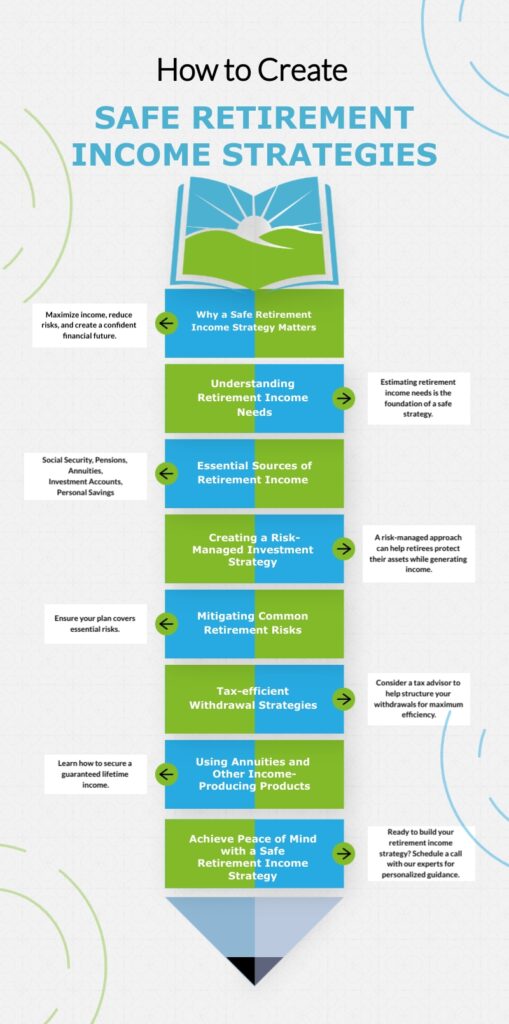
Why a Safe Retirement Income Strategy Matters
Retirement is an exciting milestone, but transitioning from a steady paycheck to relying on savings and investments can be daunting. For many, creating a secure retirement income strategy is critical to maintaining their lifestyle, covering unexpected costs, and enjoying peace of mind. This guide explores essential steps, tools, and principles for building a solid retirement income plan that reduces risk and ensures reliable income, even in uncertain times.
1. Understanding Retirement Income Needs
One of the first steps in creating a retirement income strategy is determining how much income you’ll need to cover your expenses. Here are key factors to consider:
- Basic Living Expenses: Calculate monthly costs for housing, food, utilities, transportation, and other essential needs.
- Healthcare and Long-term Care Costs: Medical expenses often rise with age. Consider Medicare premiums, out-of-pocket costs, and potential long-term care needs.
- Lifestyle Expenses: Include entertainment, travel, and hobbies in your income plan to ensure you can maintain your lifestyle.
- Inflation: Factor in inflation to ensure your income will keep pace with rising costs over time.
Estimating your retirement income needs is the foundation of a safe retirement income strategy, helping you make informed decisions about savings and investments.
2. Essential Sources of Retirement Income
A safe retirement income plan draws from multiple sources to create a balanced, reliable stream of income. Here’s an overview of the main income sources:
- Social Security: This government benefit is the foundation of income for most retirees. Strategies for maximizing Social Security include delaying benefits to age 70 to receive the highest possible payout.
- Pensions: While less common today, pensions provide a steady income source for some retirees. Review your pension options to ensure you choose the payout method that best suits your needs.
- Annuities: Annuities offer predictable income over a set period or lifetime, making them an effective tool for creating stability.
- Life Insurance Cash Values: Certain permanent life insurance policies, such as whole life or universal life, accumulate cash value over time.
- Investment Accounts: Accounts like IRAs, 401(k)s, and taxable brokerage accounts can supplement retirement income through withdrawals.
- Personal Savings: Emergency funds and other liquid savings can cover unexpected expenses or bridge income gaps.
Learn more about Social Security to see how you can make the most of your benefits.
3. Creating a Risk-Managed Investment Strategy
Investing in retirement requires a careful balance between growth and security. Here are strategies to manage investment risks while generating income:
- Asset Allocation: Diversifying your portfolio across stocks, bonds, and other assets helps protect against market volatility.
- Withdrawal Strategies: Adopting a safe withdrawal rate (such as the “4% rule”) can help ensure you don’t outlive your assets.
- Portfolio Diversification: Spreading investments across asset classes and geographies can reduce risk while providing opportunities for growth.
- Protective Financial Tools: Insurance products, annuities, and other guaranteed-income products can help safeguard your income.
A risk-managed investment approach can help retirees protect their assets while still generating income.
4. Mitigating Common Retirement Risks
Retirement comes with unique risks that can impact your income. Planning for these risks is essential:
- Longevity Risk: People are living longer, increasing the chance of outliving savings. Strategies like annuities or delaying Social Security benefits can help ensure you don’t run out of income.
- Inflation: Rising prices reduce purchasing power over time. Investing in assets with inflation-beating potential or adjusting income sources can help.
- Healthcare Costs: Medical expenses are a significant risk, especially as people age. Consider Medicare, supplemental insurance, and long-term care insurance.
- Market Volatility: Financial markets are unpredictable. Diversification and safe withdrawal rates can help protect income against downturns.
Download our “New Retirement Report” to ensure your plan covers essential risks.
5. Tax-efficient Withdrawal Strategies
Minimizing taxes is a key part of a retirement income plan. Tax-efficient withdrawal strategies can help you make the most of your savings by minimizing taxes.
- Tax-deferred Accounts: Withdrawals from accounts like IRAs and 401(k)s are taxed as income, so strategize carefully to avoid high tax brackets.
- Roth Accounts: Roth IRAs offer tax-free withdrawals, making them valuable for managing tax liability.
- Taxable Investments: Capital gains from taxable accounts may be taxed at lower rates, depending on how long you’ve held the investments.
- Required Minimum Distributions (RMDs): Starting at age 73, RMDs are mandatory from tax-deferred accounts. Failing to withdraw the required amount results in significant penalties.
Working with a tax advisor can help you structure your withdrawals for maximum tax efficiency.
6. Using Annuities and Other Income-Producing Products
Annuities can provide a guaranteed income stream, making them an effective component of a retirement income strategy. Here are some common options:
- Fixed Annuities: Offer consistent, guaranteed payments, providing a stable income regardless of market conditions.
- Variable and Indexed Annuities: Payments fluctuate with market performance, offering potential for growth but with some risk.
- Life Insurance: Certain permanent life insurance policies can serve as an income source, especially when structured to allow withdrawals or loans.
Discover how a client secured lifetime income with a fixed annuity by consulting our annuities guide.
7. Legacy and Estate Planning
A complete retirement income strategy includes a plan for transferring wealth efficiently. Legacy planning helps ensure that your financial legacy aligns with your values and supports loved ones.
- Beneficiary Designations: Regularly update beneficiaries on retirement accounts, insurance policies, and other assets.
- Trusts and Wills: These documents allow you to specify how assets are distributed, helping to reduce taxes and simplify the transfer process.
- Charitable Giving: For those who wish to leave a legacy of giving, charitable contributions can provide a lasting impact.
Schedule a free consultation with an estate planning specialist to learn more.
8. Building Your Personalized Retirement Income Plan
A personalized approach is essential for creating a secure retirement income strategy. Here’s a roadmap to get started:
- Step 1: Assess your projected expenses and income needs.
- Step 2: Identify all income sources and determine how each will contribute.
- Step 3: Construct an investment strategy based on your risk tolerance and income goals.
- Step 4: Plan for tax-efficient withdrawals to maximize your spending power.
- Step 5: Set up an estate plan to ensure your assets are distributed according to your wishes.
FAQs on Safe Retirement Income Strategies
What is a safe withdrawal rate?
A commonly recommended rate is 4%, although some adjust this based on personal circumstances.
How can I protect my retirement savings from inflation?
Consider investing in inflation-protected assets, such as Treasury Inflation-Protected Securities (TIPS) or stocks.
Should I consider annuities?
Annuities can provide a guaranteed income stream, especially for those concerned about outliving their savings.
Conclusion: Achieve Peace of Mind with a Safe Retirement Income Strategy
Creating a secure retirement income strategy requires careful planning, but the reward is peace of mind and financial stability throughout retirement. By following the steps outlined here, you can build a solid, personalized plan to support your lifestyle, cover healthcare needs, and preserve wealth for future generations.
Looking for Guidance?
If you’re seeking personalized advice, consider reaching out to a financial professional.. Get started by visiting our “Find a Financial Professional” section, where you can connect with someone directly. If you would like a personal referral for a first appointment, please call us at 877.476.9723 or contact us here to schedule an appointment with an independent trusted and licensed financial professional.
🧑💼Authored by Brent Meyer, founder and president of SafeMoney.com, with over 20 years of experience in retirement planning and annuities.
Disclaimer
This article and its subtopics are intended for informational purposes only and do not constitute financial, tax, legal, or investment advice. The information provided here is a general guide to retirement income planning strategies and should not be interpreted as a recommendation to buy or sell any specific financial product or service.
Please consult with a licensed financial advisor, tax professional, or attorney to discuss your specific situation and goals. Retirement planning involves numerous complex considerations, and professional guidance can help ensure your unique financial, tax, and estate planning needs are addressed. Additionally, investment decisions carry risks, and past performance is not indicative of future results.
For personalized advice and support, we recommend reaching out to a qualified retirement planning specialist.









